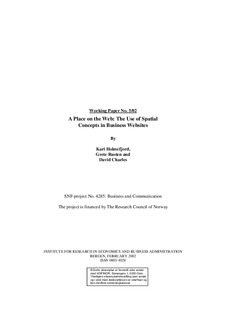A place on the web : the use of spatial concepts in business websites
Working paper

Åpne
Permanent lenke
http://hdl.handle.net/11250/165798Utgivelsesdato
2002-02Metadata
Vis full innførselSamlinger
- Working papers (SNF) [809]
Sammendrag
The communication revolution enables firms to build new links with customers and suppliers around the world. Presenting business online offers new marketing and product opportunities for trading with both businesses and consumers. However, experiences with actual information and communication technology (ICT) use in general, and the Internet in particular, show that geography still matters. One reason is that the majority of goods and services still rely upon some physical movement. In addition, regulatory barriers and cultural differences between nations still slow down e-commerce. Geography is also significant in other ways -for example, some locations attracts customers. Some firms that may have a rather limited attraction value individually have enhanced their value through clusters, which are developed with the aim of forming a regional brand. In other cases, firms downplay the use of local references and present a global image instead. This paper discusses spatial concepts expressed in firms’ websites. A general discussion shows how firms use spatial concepts in various ways to engage trust, to develop a regional brand or to express strength through cluster membership. The type of spatial statements will often vary according to the target group. The discussion is further illustrated by referring to the web pages of two industries with strong links to location: the food and tourist industries, often small and medium sized firms (SMF) based in a rural setting. Examples are taken from both the UK and Norway, but a comparative analysis has not been attempted.
Utgiver
SNFSerie
Working Paper2002:5